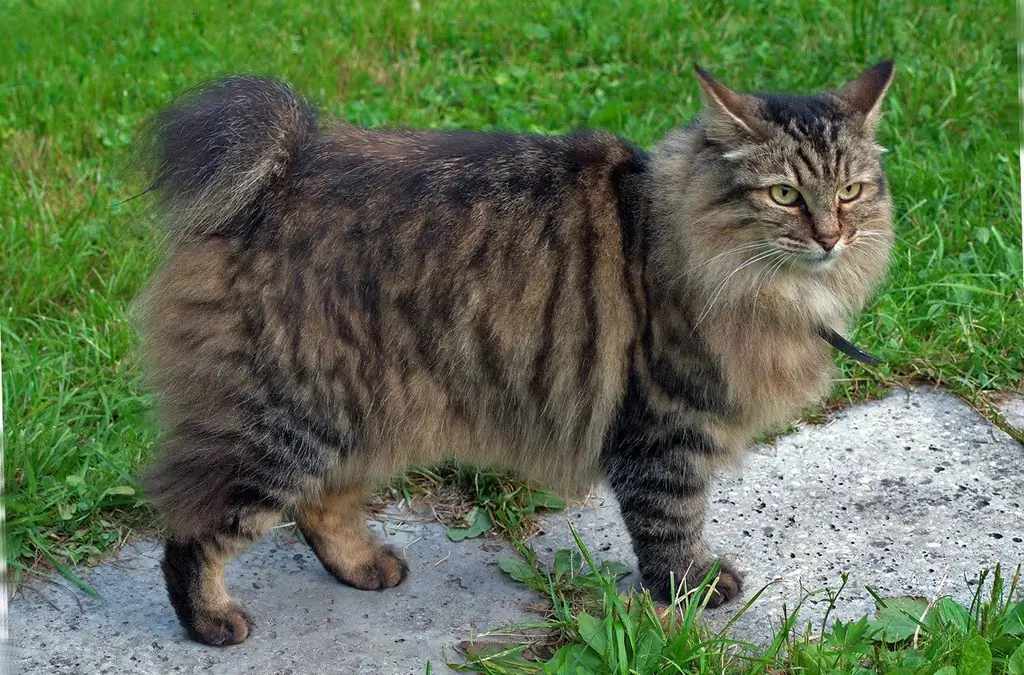
Table of contents:
- Author Bailey Albertson [email protected].
- Public 2023-12-17 12:53.
- Last modified 2025-06-01 07:32.
Bobtail - short-tailed dog in feline form

What breeds of cats do not exist in the world! A fluffy Persian or Fold Scottish cat has long been a surprise. But unusual short-tailed cats, which are called bobtails, are rare.
Content
-
1 History of origin and characteristics
-
1.1 Kurilian Bobtail
1.1.1 Video: features of the Kurilian Bobtail
- 1.2 Karelian bobtail
-
1.3 Japanese bobtail
1.3.1 Video: about the breed Japanese Bobtail
-
1.4 Mekong Bobtail
1.4.1 Video: about Mekong bobtails
-
1.5 American Bobtail
1.5.1 Video: Features of the American Bobtail
- 1.6 Table: characteristic features of different breeds of bobtail
-
-
2 The nature of the bobtail
2.1 Video: Kurilian Bobtail swimming
- 3 Health
-
4 How to care for a bobtail
- 4.1 Video: how to brush your cat's teeth
- 4.2 Toilet for the cat
-
5 How to feed a handsome bobtail
- 5.1 Table: Natural foods that must be in a cat's diet
- 5.2 Prepared feed
- 6 How to choose a bobtail kitten
- 7 Breeding
- 8 Bobtail Reviews
Origin history and characteristics
The name of the breed "bobtail" in translation from English means a short tail (bob tail). This variety includes cats with very short or no tail. This feature is due to a genetic mutation that is entrenched in the animal's phenotype.

Bobtail short tail - the result of a genetic mutation
There are several types of bobtails:
- Kuril;
- Karelian;
- American;
- Japanese;
- Mekong.
Each of them has its own origin story.
Kurilian Bobtail
The Kurilian Bobtail is considered an aboriginal Russian cat breed. This means that the cat is an indigenous inhabitant of the place where it was first discovered - on the Kuril Islands.
Currently, there is no proven theory of the origin of this breed, but there are suggestions that it was formed by combining Japanese bobtails, which were brought to the island by fishermen and merchants, and Siberian cats. For a long time, only the indigenous inhabitants of the islands and rare travelers knew about the Kuril Bobtails. The situation changed only in the 20th century. Until the 80s, tailless kittens were taken with them as exotic pets to surprise guests. And only at the end of the second millennium they began to be seriously interested in Kurilian bobtails.

The predatory look of the Kurilian Bobtails reminds of the times when they lived in the wild
The Kurilian Bobtail standard was developed in 1991 in Russia. The World Cat Federation (WCF) recognized this breed in 1994. The standard was slightly revised in 2001 and is still in effect.
Video: features of the Kurilian Bobtail
Karelian bobtail
It is believed that these tailless beauties have lived in the dense forests of Karelia for a long time. There is an assumption that the progenitors of the Karelian Bobtail were Norwegian cats, which, according to some scientists, chewed off the tails of newborn kittens. Presumably this led to the genetic mutation.

Karelian bobtails are slightly smaller than their Kuril counterparts
The Karelian Bobtail made its debut at the show in 1987, at the same time the first breed standard was described. In 1994, the World Cat Federation (WCF) recognized these unusual pussies. Unfortunately, at present they are not very popular, they rarely participate in exhibitions.
The breed standard recognizes 2 types of Karelians:
- shorthaired (have a very thick undercoat);
- with wool of medium length.
Japanese bobtail
The origin of the breed corresponds to the name of the cat - he comes from Japan. This breed has been known for a very long time, its representatives are found in old paintings and engravings of the imperial palace.

Short-tailed cats were considered lucky in Japan

In Japan, a cat with a short tail can easily be found on the street.
In 1968, the Japanese Bobtail came to the United States, and since then this breed has become seriously interested. In 1976 short-haired "Japanese" were recognized, and long-haired were recognized in 1993.
Video: about the breed Japanese Bobtail
Mekong Bobtail
The Mekong Bobtail is another representative of the old cat breed. The banks of the Mekong River are considered the homeland of these purrs. There is a legend that in ancient times these animals guarded ancient vases in temples in southeast Asia.
For a long time these tailless beauties were a national treasure, they were not allowed to be taken out of the country. Only the most honorable guests could receive such a kitten as a gift.

Mekong bobtails were not allowed to be exported from Thailand for a long time
The breed began to develop thanks to Russian breeders. The first Mekongs came to Russia at the end of the 18th century. They were presented to Nicholas II by the Thai king as a sign of friendship between states. And if in Europe at that time a short hooked tail of bobtails was considered a defect, in Russia it was a sign of the purity of the breed.
The first standard of the Mekong cat breed was also developed by the Russians in 1994. The World Cat Organization recognized the Mekongs in 2003.
Outwardly, Mekongs are very similar to Thai cats. But they differ in the structure of the head, the setting of the eyes, the size of the ears, the height of the paws and, of course, their unusual tail.

The Mekong Bobtail has a very charismatic appearance, reminiscent of a Thai cat
Video: about Mekong bobtails
American bobtail
Another name for the American bobtail is "Yankee Bob". There are several versions of the origin of the breed. According to the first, the originator of the breed was a kitten obtained from a cat with a tiny tail and a Siamese cat found in southern Arizona in the 60s of the XX century. The baby had a short tail, and he led the breeders to the idea that short-tail is transmitted genetically.

At exhibitions preference is given to American bobtails with "wild color" tabby
According to the second, generally accepted in the circles of scientists, version, the breed was formed due to an accidental mutation that occurred when crossing ragdoll cats.
The first American bobtail standard was adopted in 1970. Unfortunately, some time after the breeding of the breed, its degeneration began to occur due to their crossing with close relatives. But in the 80s of the XX century, measures were taken to revive the American bobtail.
The first American Bobtail was recognized as an independent breed by the International Cat Association (TICA) in 1989. The Cat Fanciers Association (CFA) did this only in 2000. Currently, cats of this breed are not very popular in the world community. Geographically, they are mainly distributed in the United States and Canada.
Video: features of the American bobtail
Table: characteristic features of different breeds of bobtails
| Characteristic | Kuril | Karelian | Japanese | Mekong | American |
| Body | Compact, muscular, with a slightly arched back and raised croup. | Medium in size, neither stocky nor elongated. | Medium size. The body is graceful and long. The musculature is developed. | Medium, muscular, but graceful at the same time. | Medium size. The chest is wide. The body is muscular. |
| Limbs | Strong. The hind legs are longer than the front ones, the paws are rounded. | Of medium length and strong, the hind legs are slightly longer. Paws are rounded. | Long, slender, strong. The hind ones are much longer than the front ones, which can be seen with the naked eye. Oval feet. | Medium, slender. Oval feet. | In proportion to the body, strong. In long-haired individuals, tufts of hair between the toes are welcome. Paws are large, rounded. |
| Tail | From 3 to 8 cm excluding wool. Must have kinks and bends, one or more knots in various combinations. The hair on the tail forms a pompom. | From 4 to 13 cm. Kinked or curved. The wool forms a pompom at the end. | No longer than 3 inches (7.62 cm), but visible. Can be composed of one or more bends, corners, etc. | Must have at least 3 vertebrae, but at the same time, a size longer than 1/4 of the body is not allowed. Hooks and knots on the tail can be in any combination. | 2.5 to 8 cm. |
| Head | Large, trapezoidal, with smooth contours. The muzzle is wide. | Has the shape of an isosceles triangle. The profile is almost straight. The forehead and cheeks are flat. The muzzle and chin are narrow. | The shape of an equilateral triangle, but outwardly seems long and elongated. The nose is long and wide. Cheekbones are high. | Rounded shape. The top is almost flat. The muzzle is oval. The nose is "Roman" (wide with a hump). | Wedge-shaped, with rounded contours. Proportional to the body. The muzzle is wide. Distinct cheeks and mustache pads. |
| Ears | Medium in size. Wide. Quite wide set. Rounded tips. | Large, set high, upright. | Large, set wide apart. Pointed up. | Large, wide at the base. The tips are slightly rounded. Set high and slightly laid back. | The ears are medium to slightly larger with slightly rounded tips. Tassels on the ears are a desirable feature. The nose is wide, with a slight hump on the bridge of the nose. |
| Eyes | Rounded, set wide apart. The color is in harmony with the color. | Oval shaped, close set. The color matches the color. | Large, oval. In profile it can be seen that they have a pronounced slope. The eyes are in harmony with the color, although blue-eyed individuals and even with different eye colors are acceptable. | Large, oval, bright blue. | Large, almond-shaped. Color may not match, except for mink, sepia and colorpoint. |
| Wool | Middle length. The undercoat is poorly expressed. It is desirable to have a "collar", "frill", "pants", ear brushes and brushes. | Short or medium length. | It can be of any length: short, elongated and long. Accordingly, there are short-haired and long-haired individuals. The undercoat is poorly defined in every Japanese bobtail species. On the tail, the hair forms a pompom. A shorter coat is possible on the front of the body than on the back. Presence of tufts in the ears and legs is desirable. | Short, silky. The undercoat is poorly expressed. | There are short-haired and long-haired. In both cases, the coat is very dense, the undercoat is moderately developed. Individuals with long hair on the chest, legs, belly and tail have increased hairiness. |
| Color | All colors are recognized, except for chocolate, lilac, cinnamon, fawn (including tabby, bicolor, tricolor), as well as acromelanic (colorpoint). | All colors are recognized, except for chocolate, lilac, cinnamon, fawn (including tabby, bicolor, tricolor), as well as acromelanic (colorpoint). | All colors are allowed except chocolate, lilac, colorpoint, ticked tabby. The most common are bicolor and tricolor. | A colorpoint of any point color without white. The legs, tail and muzzle are darker in color. | It can be different. The preferred coat color is tabby. |
| Weight | Cat - 5-6 kg, cat - 3-4 kg. | Cat - 4-6 kg, cat - 2.5-4 kg. | A cat is 2.5-3.5 kg, a cat is 4-5 kg. | A cat - 2.5-4 kg, a cat - up to 6 kg. | 4-7 kg. Cats are usually larger than cats. |
| Height at the withers | Up to 30 cm. | Up to 28 cm. | Up to 32 cm. | Up to 30 cm. | Up to 30 cm. |
The nature of the bobtail
The common features of any bobtail are benevolence and affection for the owner. For this love and devotion to man, they are often called dogs in feline form.

Japanese figurine of a cat with a raised paw - maneki-neko - brings good luck
Bobtails are distinguished by their high learning ability, playfulness and irrepressible energy. These cats can be walked on a leash.
Problems with training can arise from the owners of Japanese bobtails - these are rather stubborn animals. It is difficult to get them to do any trick. But Kurilian Bobtails, on the contrary, are very obedient and unforgettable. The owner only needs to point out the pet's fault once, and the smoker will never do it again. Moreover, the owners note that these intelligent animals never mark their territory. And this is an indisputable plus when it comes to a cat.
Bobtails are excellent rat-catchers. Their hunting instinct does not disappear even in those cats that have never seen a mouse. Moreover, they get along very well with numerous small pets: parrots, hamsters, etc. These cats are very smart and unpretentious. They are not afraid of water at all, unlike most other representatives of the feline family.

Surprisingly, bobtails love to swim
Bobtails are friendly to guests, although somewhat wary. But they get along very well with children and other pets. Even a stern-looking Kuril cat is actually kind and affectionate.
At the same time, cats of this breed are unobtrusive, although they love to sleep on the lap of their owner. They don't speak often. Their melodic meows are very different from those of other cats. Perhaps the most delicate are the Mekongs. They rarely express their emotions. But the owners of these unusual purrs noted that the Thai beauties are quite vindictive. And Karelian bobtails, as the breeders note, know how to take offense at the raised voice of their owner: on their face they depict sadness and do not approach the person who offended them until he speaks affectionately with his offended pet.
In general, bobtails are cats with completely different personalities. Among them there are grumblers, and extraordinary cuties, and fidgets, and phlegmatic people. The range of temperaments can be enumerated for a very long time. But they are united by benevolence and love for a person.
Video: Kurilian Bobtail swimming
Health
Bobtails have pretty good health. No genetic diseases have been identified at this time. However, some breeders note that the absence of a tail can cause inflammation of the anus and rectal prolapse. Therefore, it is extremely important to periodically examine the animal for redness or cracks in the anus. Otherwise, all types of bobtails need preventive vaccinations and antiparasitic measures, which are common for any cats.
The lifespan of bobtails is quite high. They live for about 15 years, but with proper care they can live longer.
How to care for a bobtail
The coat of these unusual cats has an amazing property: even long hair does not tangle and does not form tangles. That is why hair care is very simple: washing should be done only if absolutely necessary, and combing should be minimized. Enough 1-2 times a week is passed over the wool with a brush-mitten or a comb to remove dead hairs.
Although bobtails are not afraid of water and even like to swim in bodies of water, this does not mean that they will be just as happy to wash in the bathroom. Some cats may rebel and actively resist this procedure.

Bobtails love water, but that doesn't mean they'll also love bathing.
In some sources you can find information that you do not need to comb bobtails at all. Let me disagree with this. Yes, in the wild nobody cares for wool. But since in this case we are talking about a pet, it is necessary to periodically brush it. At least in the house there will be less pet hair, which, although not in large quantities, still appears. The same goes for the claw clipping issue. Some article authors say that tailless cats do not need it. If the cat regularly climbs trees, hunts, then perhaps there is no need to trim the claws. But if the animal lives in apartment conditions, then you cannot do without a haircut.
Bobtails of any variety need to regularly clean their ears and rinse their eyes. It is enough to do this 1-2 times a week. The procedure for cleaning the ears consists in wetting a cotton pad in a special solution and shallowly rubbing the ears with it. To wash the eyes, you should also moisten a cotton pad with warm water and remove the discharge from them in the direction from the outer corner of the eye to the inner one.
Don't forget about your teeth. They must be cleaned once a week, as tartar forms in the absence of oral care, which can lead to serious health problems.
Video: how to brush your cat's teeth
Toilet for a cat
Bobtails get used to the toilet very quickly, usually it happens even in the parental home. From some breeders, you can hear that in order for a kitten to adapt faster after arriving at the house to new owners, you need to buy the same tray that he used in the cattery.
Since the bobtail is a medium-sized cat, you need to purchase a fairly large tray. The assortment of goods for cat litter is very large, but, first of all, a cat will choose a suitable model. If she doesn't like the purchased toilet, she will simply ignore it.
The filler issue is solved in the same way. One cat will calmly go to the toilet on the scraps of newspaper laid in it, and the other will do its "dirty" business only in a filler with high absorbency. One rule is always the same: the tray must always be clean, as bobtails are large cleanliness. Otherwise, the cat will simply go to the toilet elsewhere. And the owner will not like it.
How to feed a handsome bobtail
Until the kitten reaches the age of three months, it is recommended to adhere to 6 meals a day. At six months, the number of feedings should be reduced to 4 times, and at 9 months, the pet can be transferred to an adult feeding regimen - 2 times a day. You can feed the bobtail with both natural products and ready-made industrial feed.
Table: Natural Foods Must-Have in a Cat's Diet
| Product | Feeding frequency |
| Raw frozen beef - for a kitten at least 30 grams, for an adult cat - 100-120 grams. | Everyday. |
| Boiled chicken without bones | 3-4 times a week. |
| Chicken or beef offal (heart, lungs, liver, kidneys) in raw (frozen) or boiled form. | 2-3 times a week. Liver - once a week. |
| Boiled low-fat fish, boneless, preferably seafood (infrequently, since fish destroys vitamin B in the cat's body). You cannot give raw fish - it leads to the appearance of worms. | Cats - 1-2 times a week, cats - 1 time per week or less. |
| Egg yolk (protein cannot be given) raw or boiled in pure form; can be grinded with milk, kefir, added to porridge. | 1-2 times a week. |
| Fresh goat milk, either raw or boiled or dry from a veterinary store (only for kittens up to 3 months old, since milk in an adult cat is not digested and causes indigestion, and the kitten needs it). You can add a little honey (no sugar). Also given to pregnant and lactating cats. | You can switch to fermented milk products every day if you have an upset stomach. |
| Liquid milk porridge (for kittens under 3 months old): semolina, rice, oatmeal. Without sugar, you can have a little honey. | You can every day. |
| Fermented milk products: kefir, sour cream, fermented baked milk, yogurt, cream - all medium fat, as well as cheese. | You can every day. Cheese once a week. |
| Fresh non-acidic curd - can be mixed with sour cream or raw egg yolk (you can add quite a bit of honey). | Kittens - 3-4 times a week. Adult cats - 1-2 times a week. |
| Cereals: oatmeal (steamed), rice, buckwheat, wheat groats (boiled) - mixed in a 1: 2 ratio with boiled meat or boiled fish. | Few times a week. |
| Raw or boiled vegetables (in the form of mashed potatoes): carrots, cauliflower, green (asparagus) beans, etc. - mixed in a 1: 2 ratio with boiled meat or boiled fish. | Several times a week (alternate with cereals). |
| Greens - lettuce, spinach - are crushed and added to food. Better - germinated grains of wheat or grow grass on the windowsill (from wheat or oats). NO grass from the street! | Add to food several times a week, if there is grown grass, the cat will eat it herself. |
In some sources you can find information that it is better not to give fish to cats. However, in the natural habitat of Kurilian Bobtails, fish was an important part of their diet. And my personal experience is that fish in moderation in a healthy cat's diet will not harm her. I often fed my cats with fish, no one had kidney problems.
The following food is prohibited:
- food from the human table;
- salty, fried, smoked, sweet food;
- pork, lamb;
- goose, duck;
- spleen, chicken necks and bones;
- seafood;
- cream, sour cream, butter, salted cheese;
- citruses, kiwi, pineapple;
- persimmon;
- rhubarb;
- nuts;
- beans;
- potatoes, broccoli;
- onion garlic;
- tomatoes, eggplants;
- mushrooms;
- chocolate;
- Tea coffee;
- alcohol;
- bread and other pastries.
The proportion of proteins, fats and carbohydrates should look like this: 60-70% protein, 10% fat and 20-30% carbohydrates. Check with your veterinarian for serving size.
There are 2 ways to determine the required amount of food:
- measuring portions with scales at the rate of 5-7% of the cat's weight;
- determining the amount of food by observing the animal (a happy purring cat is a sign that he is full).
On the one hand, the second method for determining portion size is optimal, since each animal's appetite is different. But on the other hand, it can lead to obesity of the furry pet. In my opinion, it is still better to use the first method.
Finished feed
Finished feeds are divided into dry and canned foods. It is better to give preference to the latter, as they are considered more beneficial for the cat's health. But often bobtails choose exactly the food on the "drying", as experienced breeders say.
Often on cat forums, you can witness heated debates regarding the combination of natural food with dry and canned food. Some breeders insist that mixing all types of feeding is possible - this is only for the benefit of cats. Others are categorically against it, as they believe that such a combination of food can lead to serious health problems. In order not to harm the pet's health, this issue needs to be resolved only with a specialist.
Serving size must comply with the standards indicated on the package, it can only be adjusted by a veterinarian. It should be noted that for kittens it is necessary to buy special food designed specifically for them.

In order not to overfeed your pet, you need to monitor the portion size.
How to choose a bobtail kitten
These cats are exotic, so it is better to buy from catteries and breeders with a good reputation. First of all, before purchasing an animal, you should decide on its gender, as well as the length of its wool.
Cats are usually more docile and affectionate than cats. But cats are more playful. An important question in deciding on the sex of the animal is whether you want to receive income from the sale of kittens. If so, then you need to choose a kitty. If the continuation of the feline family is not included in the plans, then the animal can be neutered or spayed. This is done before the onset of its sexual maturity, that is, at about 6 months.
Despite the fact that bobtails do not need special grooming, it is still easier to care for short-tailed breeds. This must be taken into account by those people who are very busy and will not be able to comb their handsome man 2 times a week.
The general rules for choosing a kitten do not differ from buying an animal of a different breed:
- The kitten should be playful, not afraid to approach people.
- Keep your skin, eyes and ears clean.
- There should be no redness or cracks on the anus.
-
It is recommended to separate kittens from their mother no earlier than 3 months after birth, this is the optimal age for buying.

3 month old kurilian bobtail Kittens can be bought after all vaccinations are done
- The tummy should not be swollen.
- The mouth should be clean and pink. A pale color indicates anemia, and a red color indicates an inflammatory process. The presence of sores and black crusts indicates a viral infection.
The real bobtail has a short tail. The presence of kinks and hooks depends on the breed. Mekong Bobtails are usually born white, and they get their characteristic color closer to the year of life.

All bobtail kittens are distinguished primarily by a short tail.
The following prices for kittens are found on the Internet:
- Kuril - from 10 thousand rubles;
- Karelian - from 30 thousand rubles;
- Japanese - from 15 thousand rubles;
- Mekong - from 10 thousand rubles;
- American - from 30 thousand rubles.
Breeding
To knit bobtails, you should adhere to the following recommendations:
- At the time of mating, the cat should have 1-2 heat. Moreover, she should not be younger than 1 year, since before this period her body is not yet fully formed. The cat must also be at least 1 year old. The optimal age is one and a half years.
- At least one partner must already be experienced in this matter so that the mating does not disturb the confusion of both animals.
- Both partners must be healthy, vaccinated and progistogenic 14 days before this day.
- You can not wash the kitty before mating, so as not to deprive her of the natural smell that attracts the cat so much.
- The meeting should be made on the territory of the cat so that he feels like a master and does not waste time on adaptation.
- Mating is prescribed for 2-3 days of estrus. The cat should be left with the cat for 3-5 days.
A feature of bobtails is that it is forbidden to cross them with cats of other breeds. It should also be borne in mind that when choosing a partner, you need to pay attention to the length of his tail. If a cat's tail reaches 8-12 cm in length, then in a cat it should be much shorter - this is how offspring with a tail from 3 to 8 cm is obtained.
Usually, pregnancy and childbirth are uneventful. But if the owner is inexperienced, it is better to play it safe and invite a veterinarian to give birth.
Bobtail reviews
The Bobtail is an active, playful cat. It is not suitable for a person who prefers a calm animal, but in all other respects, it is an ideal pet. Bobtail is obedient, funny, clean and does not require special care. The breed is relatively young, so it is not very common among animal lovers, but I want to believe that these beautiful cats will become more and more.
Recommended:
Scottish Straight Cat Scottish Straight: A Description Of The Breed With A Photo, The Nature And Characteristics Of Care, The Choice Of A Kitten And Reviews Of The Owners
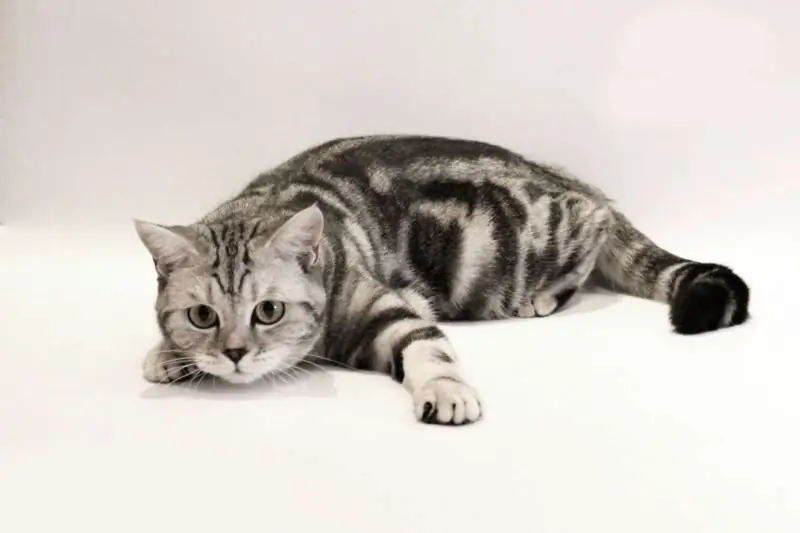
Features of the Scottish Straight breed: appearance, character, difference from British shorthair cats. How to choose a pet, take care of him. Owner reviews
Kurilian Bobtail: Photo, Description Of The Breed, Character And Behavior Of The Cat, Reviews Of The Owners Of The Cat, The Choice Of A Kitten
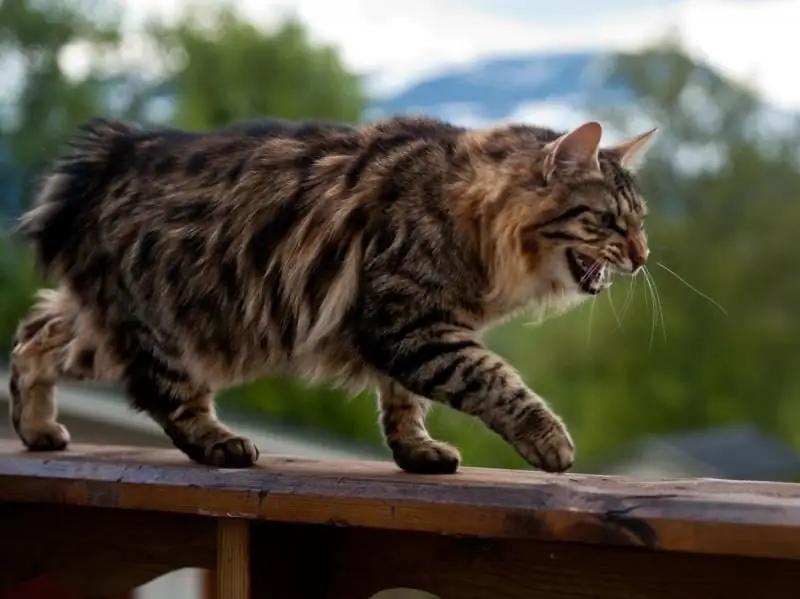
The history of the Kurilian bobtail. Description of the breed. The nature and behavior of Kuril cats. Diseases of the breed. Buying a kitten breed. Care and hygiene. Breeding. Reviews
Chausie: Description Of The Breed, Character And Habits Of A Houseie Cat, Photo, Choice Of A Kitten, Reviews Of Cat Owners
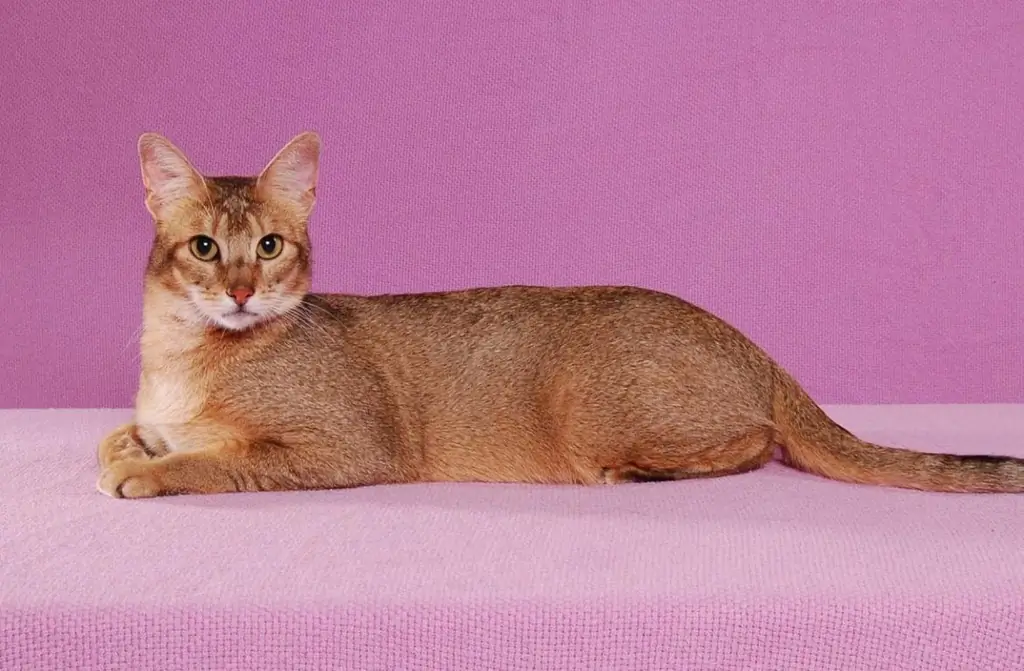
The history of the origin of Chausie. Breed standard. Character, behavior, health. Features of nutrition. Tips for choosing a Chausie kitten. How to breed. Reviews. Video
Likoy: Description Of The Breed, Features Of Character And Care, Photo And Price, Reviews Of The Owners, Choice Of A Kitten

Features of the character and behavior of cats of the Lika breed. Maintenance and care. Breeding the breed. How to choose a kitten, cost. Owner reviews
Black British: Features Of The Breed, Character And Care Of The Cat, Photos, Choice Of A Kitten, Reviews Of The Owners Of The British Cat
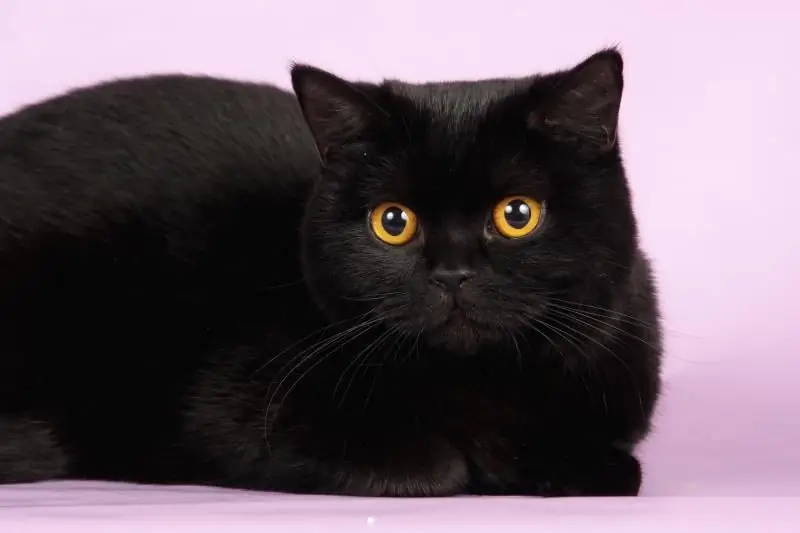
Where is the breed bred, what are its main differences, what character does a black Briton have, how to properly care for him, feed him, how to choose a kitten
